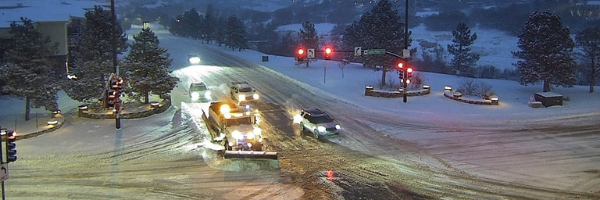Frequently Asked Questions About Snow Removal
What can I expect regarding snow removal prior to, during, and after the storm?
During heavy snowstorms, plows will often clear lanes simultaneously. Multiple snowplows often plow together to remove snow from multi-lane streets. This results in more efficient operation and eliminates piles of snow in the roadway that may become obstructions to vehicles. When you see this process in action, please give equipment adequate room to operate. Do not drive within a snowplow operator’s blind spot as he/she is not able to see you. For personal safety, never pass a snowplow that is engaged in snow removal. Snow and ice that comes off the plow blade can damage your vehicle or greatly obstruct your vision. Passing an operating snowplow in “echelon formation” with two or more snowplows arranged diagonally is now a Class A traffic offense, punishable by a fine of up to $100.
Castle Pines clears all roadways according to priority until conditions are safe for travel. Cul-de-sacs and some local streets may not be plowed if accumulations are minor and snow is expected to melt over the following 24 to 48 hours. Exceptions to this are made if the streets have hills or curves that may become icy and hazardous to traffic.
Depending upon temperatures, wind velocities, and the extent of snowmelt, crews may have to widen travel lanes, remove ice, and perform other operations for several days after a snow event. Snow from adjacent properties can melt and re-freeze overnight, creating ice buildup on the street. To report ice buildup on a street, please complete the Public Works Request form.
Residential streets may not be plowed if parked vehicles or other obstructions interfere with the safe and continuous operation of snow removal equipment. Equipment may return to plow after obstructions are moved. When a snowstorm is forecasted, residents are advised to move vehicles off the street to allow safe access by snowplows.
Snow Removal FAQs
Why doesn’t the City plow my street when they go by?
Routes are plowed on a priority basis, with arterial roadways (primary access roads that provide critical connections throughout the community), collector roadways (primary access into and out of residential areas), and school routes being top priorities. Clearing those roadways first enables emergency services to access all residential areas normally within a few blocks of each residence.
Who is responsible for clearing sidewalks?
Residents are responsible for clearing driveway entrances and sidewalks within 24 hours after a snowstorm to allow safe use by pedestrians. This is particularly important along school pedestrian routes to prevent children from having to walk in the street. It is requested that residents place snow from their driveways and sidewalks onto their front yard and not into the street. This practice reduces the number of icy areas on streets and ensures proper drainage flow into the storm sewer. Additionally, your lawn can use the available moisture over the winter. Commercial parking lots are prohibited from pushing snow into the public right-of-way.
Are cul-de-sacs plowed after every storm?
Local streets and cul-de-sacs are plowed after every storm unless the snow is expected to melt over the following 24 hours. An exception is if the street has hills and curves that could become hazardous to motorists. With heavy storms, snow may not be removed until arterial roadways and collector roadways are plowed.
When plowing, why don't you pile snow on the side of the street that melts quicker?
Plowing crews cannot flip the plow back and forth due to curved roads. Additionally, the City's plowing process on residential streets includes plowing one lane in each direction. If snow were piled higher on the side of the street that melts quicker, the residents who live on that side would have more snow to remove from their sidewalks and driveway entrances.
After the storm, the snowplow came through and pushed snow back into my driveway entrance or sidewalk, why?
Cleanup and widening operations often occur one to four days after the snowstorm, depending upon the storm's severity and wind conditions. It is often necessary to widen roads to ensure ice and snow melt from the pavement surface to keep driving lanes open. Unfortunately, subsequent widening operations may push snow back onto sidewalks and driveway entrances. This next snow on the sidewalks remains the adjacent property owner's responsibility.
What if I have an emergency and my street isn’t plowed?
If an emergency situation occurs, call 911. Equipment will be diverted for emergencies ONLY WHEN REQUESTED BY AN EMERGENCY SERVICE AGENCY OR THE DOUGLAS COUNTY SHERIFF’S OFFICE. The Sheriff’s Office is in constant communication with public works operations personnel during snow events so snow removal equipment can be detoured to assist with emergency response.
Who is responsible for damaged mailboxes?
Mailboxes installed along roadways are at the risk of the owner. Mailboxes damaged from lack of owner maintenance, heavy snow from plowing, or vandalism are not the responsibility of the City. Postal regulations require residents to clear snow from in front of mailboxes to allow for mail delivery.
